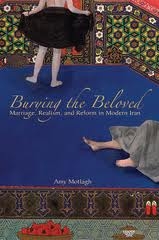|
Reviewed by Kelly J. Shannon, Ph.D., Assistant Professor, Department of History, University of Alaska Anchorage Amy Motlagh’s Burying the Beloved is a creative and insightful contribution to the study of literature and gender in modern Iran. Motlagh seeks to understand the changing status of women in Iran through the lens of prose fiction by focusing on how Iranian authors dealt with the subject of marriage. Her approach allows her both to contextualize some of the major works of modern Persian fiction while also analyzing how writers negotiated and sought to influence debates about women’s status in society. According to Motlagh, “I view marriage as a metaphor for the social and legal reforms of the period and as an actual site of reform itself.” (p. 4) She thus examines how key novels and short stories represented marriage and women during five periods of reform and argues that the fictional and legal discourses about women and marriage in Iran were linked. She begins by analyzing Sādeq Hedāyat’s The Blind Owl (1937) and Bozorg ‘Alavi’s Her Eyes (1952). While both novels are the subjects of countless scholarly studies, Motlagh offers new insight by studying them in relation to one another and to the modernizing legal reforms imposed during the reign of Reza Shah. She argues that both novels express male anxiety over the Pahlavi reforms, which remade gender relations by replacing traditional arranged marriage with “companionate” marriage and by turning the formerly male public realm into a heterosocial space. Motlagh claims that The Blind Owl and Her Eyes demonstrate “profound anxieties about women in the public sphere, and of the newly public nature of the formerly private union of marriage, suggesting the ambivalence with which the civil code reforms were received” (p. 34). The bulk of Motlagh’s book then focuses on the writing of women over the course of the twentieth century. In her second chapter, she argues that Sadīqeh Dawlatābādī’s “A Pitiful Tale” (1918), Zahrā Khānlarī’s “Gawhar” (1945), and Sīmīn Dāneshvar’s Savūshūn (1969) celebrated the new ideal of the “companionate wife” and thus supported the Pahlavi regime’s attempts to modernize women’s status. Through the short stories of Dāneshvar and Golī Taraqqī, Motlagh then demonstrates in Chapter 3 how changes in marriage laws also affected women who lacked the status of wife: female servants. Her fourth chapter then examines marriage after the 1979 Revolution, when the Islamic regime moved to roll back the Pahlavi-era gender reforms. Novels such as Shahrnūsh Pārsīpūr’s Touba and the Meaning of Night (1989) demonstrate women’s attempt to grapple with their loss of rights and the “state-sanctioned lawlessness” of the immediate post-revolutionary period (p. 95). Later novels like Fattāneh Hājj Sayyed Javādī’s The Morning After (1995) and Zoyā Pīrzād’s I’ll Turn Out the Lights (2001), the subject of Chapter 5, reflected the growing rights discourse for women in Iran during the presidency of the reformist Mohamad Khātāmi (1997-2005). Motlagh concludes her analysis by moving beyond literature to examine the ways in which cinema has pushed the boundaries of state censorship to take up the mantle of critical engagement with contemporary debates about gender, marriage, and rights in Iran. Motlagh’s study is sweeping in scope and offers much insight into modern Iranian literature and notions of women’s “proper” place. It is most useful as a work of literary criticism, however, particularly for readers already familiar with the texts she analyzes. Though Motlagh is clearly well-versed in the history of modern Iran, her treatment of that history is superficial, which limits her ability to place works of literature in conversation with their historical contexts. She also fails to deliver on all of her promises. Motlagh states that one of her primary goals is to explain how these various works of fiction were understood, both at the time they were written and later. Yet the issue of reception is tricky. In the end, she primarily provides her own analyses of these works, coupled with the scholarly literature when it exists. As innovative and insightful as her analyses are, she rarely attempts to demonstrate how Iranian audiences understood these novels. When she does, she mainly offers conjecture without evidence. She would be better served by eliminating her argument about audience reception altogether. Last, it is difficult to gauge change over time because Motlagh’s object of study changes with each chapter, culminating with her abandonment of literature altogether. Her constantly shifting focus at times makes it difficult to trace her overarching argument. Despite its flaws, however, Burying the Beloved has much to offer anyone interested in debates about marriage, gender, and modernity in Iran. By focusing on fiction, Motlagh provides a new lens through which to understand how Iranians negotiated the dramatic and nearly constant changes in women’s status imposed by the various regimes of the twentieth century. Her study demonstrates that state reforms were never quite as smooth or complete as each regime claimed. Literature – and later cinema – offered a site where authors could resist, support, or complicate the state’s efforts to remake marriage and, through it, Iranian society. |


 Burying the Beloved: Marriage, Realism, and Reform in Modern Iran
Burying the Beloved: Marriage, Realism, and Reform in Modern Iran